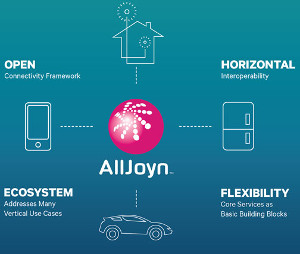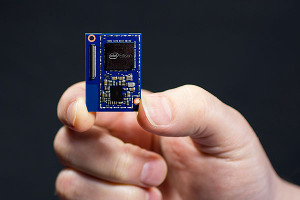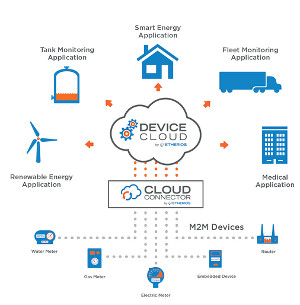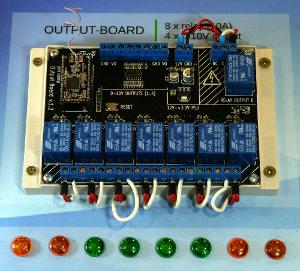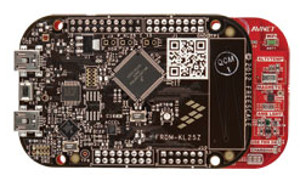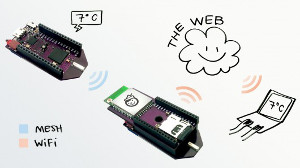The MeshWorks Internet-of-Things platform from California Eastern Laboratories is a turnkey wireless solution which connects sensors and peripherals to the cloud in a way that makes previously complex mesh networks and wireless sensor networks very fast and easy to implement.
This includes connectivity between the wireless mesh network, the LAN, the Internet and cloud services, for anyone with rudimentary Python scripting skills. The complete MeshWorks platform consists of three key components – a wireless Personal Area Network (PAN) which is powered by CEL’s MeshConnect 2.4 GHz 802.15.4 radio modules. Programming is via a GUI-based interface built around the MeshWorks software suite, and the cloud service which is facilitated by connecting your wireless sensor network to the Internet via either the MeshWorks Ethernet Gateway or the OpenTether Cellular Gateway.
CEL provides a variety of reference designs which allow you to easily get started engineering, combining the EM35x MeshConnect family of 802.15.4/ZigBee wireless modules with a multitude of different sensors and control node choices representative of those that are popular in Internet-of-Things and connected-home applications. CEL’s turnkey wireless solutions enable you to unite the “Internet of Everything” product ecosystem with ease.
The MeshWorks platform was designed specifically to address the wireless connectivity needs of the industrial and environmental sensing markets. By using CEL’s family of EM35x wireless modules in conjunction with the MeshWorks cloud service platform, virtually any sensor or control node can easily be connected to the cloud for state-of-the-art control and data analytics, allowing you to get to market quickly and easily.
Furthermore the included library of reference designs for proven hardware implementations and solutions include block diagrams, detailed schematics, bill of materials information, and much other relevant information to help you get started with a MeshWorks-based solution for your next product.
The MeshConnect line of 802.15.4/ZigBee and other radio solutions combine industry-leading transceiver ICs with other RF components such as RFIC switches and power amplifiers, providing certified and qualified solutions which enable customers to reduce their design and certification phases of development, enabling wireless connectivity for your products relatively easily.
The MeshConnect EM35x Ember Companion Kit is designed for interoperability with development kits for the Ember platform, with each radio module in this kit soldered onto a carrier board making it pin-for-pin compatible with the Ember development board. CEL’s MeshConnect EM35x Mini Modules Programming Fixture is a programming assembly designed to be used with the CEL ZICM35xSPx MeshConnect Mini Modules series, which are small mesh-networked radio modules ready for compact and relatively low cost integration into your next product, adding wireless mesh network and Internet-of-Things capability with ease.
The Mini Modules Programming Fixture is useful for production programming or during application development when multiple firmware images are required to be flashed onto a Mini Module during testing and debugging. This programming assembly needs to be used in conjunction with the ISA3 Ember Debug/Insight Adapter from Silicon Labs for the actual programming of the chips.

Another option is to use MeshConnect EM357 USB Sticks which enable hardware vendors to quickly integrate 802.15.4/ZigBee connectivity into any computer or device with a USB port, without any RF design experience required. They can be used as a hardware development platform for rapid prototyping and as a companion to the MeshConnect EM357 modules.
CEL also offers reliable Ethernet and Cellular-based gateways, providing Internet connectivity to a wireless sensor network or mesh network with a secure, low-cost solution. Based on the Mini Module line of Ember EM35x-based IEEE 802.15.4 radio transceivers from Silicon Labs, these gateways run the industry-leading EmberZNet PRO ZigBee stack.
The MeshWorks OpenTether Cellular Gateway connects a MeshWorks sensor and control network to the cloud anywhere out in the field, as long as cellular service is available in that location. These gateways can also come pre-configured to connect a MeshWorks network directly to Exosite’s cloud service, and are specifically designed to support the MeshWorks turnkey wireless solution for connecting sensor and control peripherals to the cloud.
By writing a simple python script, the gateway can be configured to connect to virtually any cloud service or database using common Internet transport protocols, with Exosite connectivity supported out of the box with a supplied reference script.
The MeshWorks OpenTether Sensor Node is also available as a part of the MeshWorks solution family, and this product is an ideal starting point for the evaluation of the MeshWorks platform. The OpenTether Sensor Node has 10 built-in sensor capabilities to enable you to quickly prototype many common sensing and automation applications. Additionally, it contains a built-in I/O expansion port that you can use to connect to any external sensor or control node using I2C, analog, or digital I/O.
The Sensor Node comes pre-loaded with CEL’s MeshWorks firmware, which allows users to quickly write Python scripts to customise the system for their particular needs. The OpenTether Sensor Node utilises CEL’s Mini Module line of Ember EM35x-based transceivers built around Silicon Labs 802.15.4 SoCs as with the other hardware products in this family, and the Sensor Node also incorporates the EmberZNet PRO ZigBee stack.
CEL’s MeshConnect EM358x Mini Modules are based on the Ember EM3588 802.15.4/ZigBee microcontroller system-on-chip from Silicon Labs. They are pin-compatible extensions to CEL’s leading product line of EM357-based radio network modules, and they are available in both low and high power output options (+8dBm and +20dBm transmit power) to accommodate designers with different range, performance and power consumption requirements.
The Silicon Labs EM3588 system-on-chip incorporates a 2.4 GHz RF transceiver with a baseband modem, a hard-wired MAC and an embedded 32-bit ARM Cortex-M3 microcontroller with 64 kB of internal RAM and 512 kB of flash memory. The MeshConnect EM357 High Temperature Mini Modules from CEL provide the same high performance RF solution and high performance ZigBee stack in a module that is specifically designed to address the thermal challenges associated with heat-intensive applications, based on the Ember EM357 802.15.4/ZigBee radio network system-on-chip.
MeshConnect EM357 Mini Modules offer the smallest footprint of all Ember-based RF modules available today, combined with the power of the Cortex-M3 advanced 32-bit microcontroller architecture, the strong performance of the EmberZNet PRO ZigBee stack, a link budget of up to 123 dB, and a strong surrounding ecosystem of gateways, sensor products, cloud services and reference designs for implementing your wireless sensor networks and Internet-of-Things solutions.
All of this means there exists another option, another choice, another system to get your Internet-of-Things ideas from your notebook to reality. And doing just that with any system may seem like an impossible task – however with our team here at the LX group, it’s simple to get prototypes of your devices based on the Meshworks platform up and running – or right through to the final product. We can partner with you – finding synergy with your ideas and our experience to create final products that exceed your expectations.
To get started, join us for an obligation-free and confidential discussion about your ideas and how we can help bring them to life – click here to contact us, or telephone 1800 810 124.
LX is an award-winning electronics design company based in Sydney, Australia. LX services include full turnkey design, electronics, hardware, software and firmware design. LX specialises in embedded systems and wireless technologies design.
Published by LX Pty Ltd for itself and the LX Group of companies, including LX Design House, LX Solutions and LX Consulting, LX Innovations.

